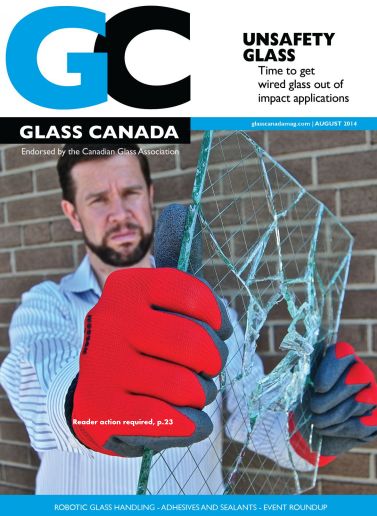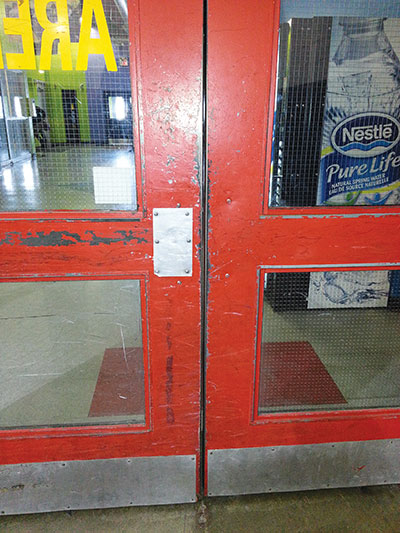 It has been a while since I’ve posted about the hazards of traditional wired glass, but the problem has not gone away. Although the US codes have changed, there are millions of existing pieces of this glass in schools and other buildings. Canada has seen several lawsuits lately – 1 worth more than 5 million dollars, and what’s particularly interesting is that some of the glass in question met the code requirements in place in Canada at the time of installation, but facilities may still be held liable for wired glass injuries because they should have been aware of the hazard and addressed it. I am posting the article below with permission from the author, Rob Botman. The article first appeared in Glass Canada, and a reprint can be downloaded by clicking here. There is additional information about the requirements for glazing on the Glass tab above.^
It has been a while since I’ve posted about the hazards of traditional wired glass, but the problem has not gone away. Although the US codes have changed, there are millions of existing pieces of this glass in schools and other buildings. Canada has seen several lawsuits lately – 1 worth more than 5 million dollars, and what’s particularly interesting is that some of the glass in question met the code requirements in place in Canada at the time of installation, but facilities may still be held liable for wired glass injuries because they should have been aware of the hazard and addressed it. I am posting the article below with permission from the author, Rob Botman. The article first appeared in Glass Canada, and a reprint can be downloaded by clicking here. There is additional information about the requirements for glazing on the Glass tab above.^
Breaks on impact
Wire glass should not be considered safety glass.
Written by Rob Botman
It was May 9, 2013, and Sean Lloyd was about to have a very bad day. It was the day he was going to learn a lot more than he ever wanted to about wired glass.
Sean Lloyd was a grade 12 student at Assumption Catholic Secondary School in Burlington, Ont. He was late for class and was rushing up the stairs when he tried to open the fire doors in the stairwell by pushing on the wired glass lite instead of the door’s push bar. Unfortunately for him, he put his arm right through the glass.
When wired glass breaks, the wires actually hold the shards of glass together. This is its main feature, after all. In fires, this serves to retard the spread of smoke and flame through the building. This is why it was installed in the first place. But it is not what you want when you penetrate the glass with your arm.
The wires and broken glass snared Lloyd’s arm, lacerating it. He carved out a chunk of his forearm, severing arteries and tendons. He lost two pints of blood and needed 48 stitches to sew a flap of his arm back on. He suffered a permanent loss of sensation in the arm. And he was lucky. There have been hundreds of similar accidents in North America over the years. Many other people have suffered far worse injuries than Lloyd.

Is this the best we can do? The missing paint from these doors reveals how people smash them open with their hockey bags. Note that the bottom left lite has already been broken and replaced by scratched-up plastic.
The Ontario School Board Insurance Exchange (OSBIE) is a branch of the provincial government that tracks various risks in our public schools and publishes its findings to help school boards prioritize ways to increase school safety. Back in 2000, they published a Risk Management Advisory on the dangers of wired glass. In their report they tracked over 107 glass injury claims against school boards over a 13-year period. The advisory says that “wired glass can cause horrible injuries” and is “extremely hazardous in impact situations.”
Paul Chowhan, manager of the Risk Management Strategies division of Health Canada says, “Every year, Canadians are injured as a result of impacts and falls into unsafe architectural glass.”
“It is scandalous,” says Jordan Richards, president of Glassopolis in Toronto. Glassopolis and its predecessor, TecniGlas, introduced the first fire-rated glass ceramics to Canada 20 years ago. “The industry has known that wired glass is not a safety glass for years. I’m glad the tide finally is turning against this dangerous glass,” he says.
What is wired glass?
Wired glass is the original fire-rated glass. It has been around for decades and has undoubtedly helped save people and buildings from fires. It was originally introduced because annealed glass cannot be used as a fire-rated glass. It breaks in a fire. Wired glass holds the glass together in a fire with a mesh of ductile metal wires. When wired glass is heated, the glass cracks as expected, but the wires hold the shards together which slows the spread of smoke and fire. However, wired glass was never intended to be impact-safe glass. It does not pass modern impact test standards. If you run into wired glass with enough force, you will regret it. So wire is for fire, not safety.
Injuries and lawsuits
The OSBIE Risk Management Advisory on unsafe glass in Ontario schools looked at glass related injuries from 1987-2000. During that time the total injury claims against the schools totaled nearly $3.2 million.
There are several lawsuits currently underway over wired glass. Sean Lloyd filed a $5-million lawsuit on April 29, 2014, against Halton Catholic School Board. The lawsuit alleges the school board was negligent in failing to replace wired glass with safer materials, despite knowing that wired glass was unsafe.
A similar lawsuit was filed against the Toronto District School Board in July 2010 by a student, Ravelle Sidial, after he went through a wired glass door in his school and suffered severed tendons in his right hand and severed an artery. He sued the school and school board for negligence.
In 2009, Devon King pushed his arm through a wired glass door at the Days Inn hotel in Kingston and suffered permanent and serious injury to his shoulder and arm. He sued the hotel for negligence.
A retired Ontario high school principal told Glass Canada, “I’ve seen it with my own eyes. A student was late for class. He broke through the wired glass door and completely severed his finger. I had to pick the finger up off the floor and give it to the paramedics.”
From the hundreds of injuries due to wired glass that have been documented it is clear that wired glass is not an impact-safe glass. The manufacturers of wired glass acknowledge that it is not a safety glass and label each case with warnings that it should not be used in locations where safety glass is required. Despite this, wired glass continues to be used. But be warned: building owners, glazing contractors and distributors should all be on notice that wired glass should not be used in safety locations, or they may face a lawsuit themselves. Some school boards have been told by their insurance companies that they must start replacing wired glass immediately with safer options. In Canada, the risk of liability is driving the glass industry to stop using wired glass immediately even as we wait for the Canadian glass standards and building codes to catch up.
U.S. reduces use of wired glass
In the United States, Americans too have had a rash of wired glass injuries over the years. But they did something about it. Wired glass was permitted in the U.S. building code when it was the only fire-rated glass available. But in the last two decades, new fire-rated glazing materials have been brought to market. These materials are wireless and perform better under fire tests and impact-safety tests. As the Americans increased their requirements for higher levels of impact-safety, particularly in doors and high traffic areas, traditional wired glass became increasingly obsolete. Wired glass use was restricted in the 2003 U.S. International Building Code and essentially excluded from human traffic locations in the 2006 edition.
This process of banning wired glass in the US was a success in part due to the detailed glass injury statistics of Ontario school children kept by OSBIE. There is some irony that the injuries sustained by Canadian kids convinced the U.S. to ban wired glass, yet Canada still allows the material.
The Canadian General Standards Board (CGSB) last revised its standard for wired glass CAN/CGSB 12.11-M90 in 1990. That edition calls the glass “Wired Safety Glass.” A review of the CGSB is now underway with a full updating of its glass standards including CAN/CGSB 12.1 Tempered and Laminated glass. It is expected that these standards and building codes will be updated and largely harmonized with those in the U.S.A., requiring that all glass in human traffic locations be impact-safe and all fire-rated applications must be certified and labeled. Health Canada’s Paul Chowhan adds, “Using impact-safe glass in all locations where there is a risk of impact from human traffic is a positive step.”
Alternatives to wired glass
For non-fire rated applications, impact safe tempered and laminated glass can be used. For fire-rated applications such as the stairwell door commonly found in schools across Canada, there are many alternatives to wired glass that are both fire-rated and safe on impact. They include:
- Glass ceramics. These materials emerged as the leading fire-rated glass options about 15 years ago. They pass both fire tests and human impact tests. They are transparent, do not contain any wires and are thin, like regular glass (5 – 8 mm). Brand names include Schott Pyran Platinum and NEG Firelite.
- Intumescent glass. This is a new class of glazing that is both fire- and impact-safe. The glass is a thicker multi-laminate (eg. 23 mm for a 60-minute fire rating). Brand names include Fireswiss by Glas Trosch, Pryostop by Pilkington and Pryobel by Glaverbel.
- Organic-coated wired glass. This is a UL-certified product that combines certified wired glass with a specially certified surface-laminated film. Since most films are highly flammable, building inspectors will only approve coated (filmed) glass that is UL-certified and labeled. Examples named include Protect3 Safety Glass by Glassopolis and UL Filmed WG from Central Glass.
“Wired glass was never able to provide impact protection for building occupants” says Dan Poling, fire-rated product manager for Schott USA. “Wired glass became obsolete when modern glass ceramics like Pyran Platinum became available, which are able to provide impact resistance and fire protection without any wires, so they are both safer and better looking.”
Labelling
In the U.S., the rules are clear. Fire-rated locations such as fire doors in school stairwells must have fire-rated, certified and labelled glass. In addition, all locations subject to human impact must be impact-safe. When these two conditions apply, the glass used must be fire-rated, certified, labelled and be impact-safe. Historically, wired glass was exempt from labeling requirements because the building inspector could easily identify what it was. Now that there are many different fire-rated options, all fire-rated glass must be individually labelled. “When fire-rated wired glass was banned in the U.S., everyone had to get used to the idea that each piece of replacement glass had to be certified and labelled” says Poling. “But labeling helps the building inspector confirm that the right glass is being used so it’s the right way to go”.
The Canadian Standards and building codes are changing, finally, and are expected to largely model what has been done in the U.S. This means that fire-rated locations that previously permitted wired glass will no longer be able to use wired glass. Instead, modern fire-rated glazing that meets both fire- and impact-safety must be used. This glass must be individually labelled and certified by the manufacturer, meaning that glaziers will no longer be allowed to cut and install un-labelled glass.
If you want to learn more about the alternatives to wired glass or how to get certified to process them, ask your Canadian suppliers.
Rob Botman is general manager of Glassopolis, a Toronto-based distributor of fire-rated and specialty glass. Glassopolis.com
You need to login or register to bookmark/favorite this content.





Leave A Comment